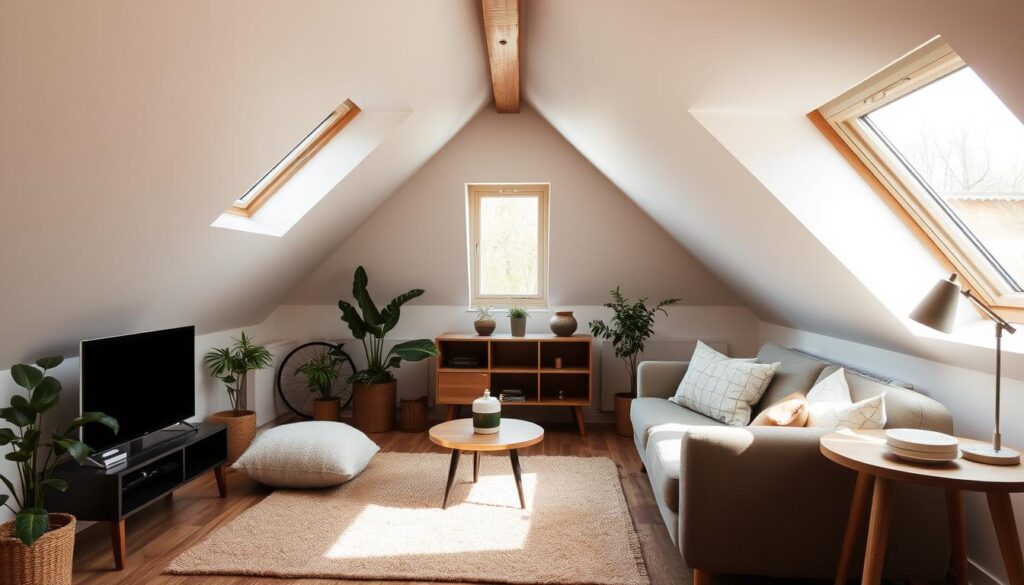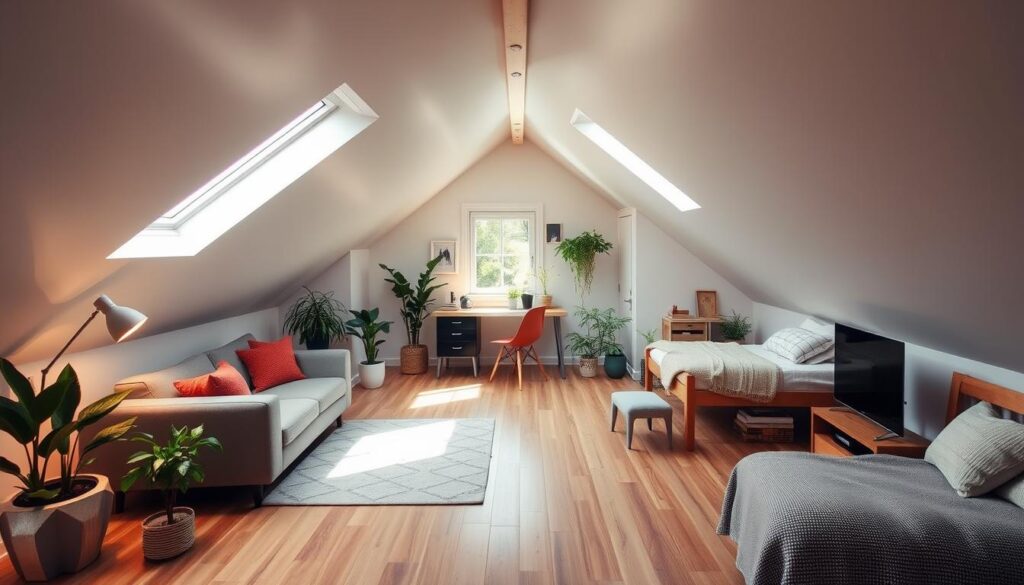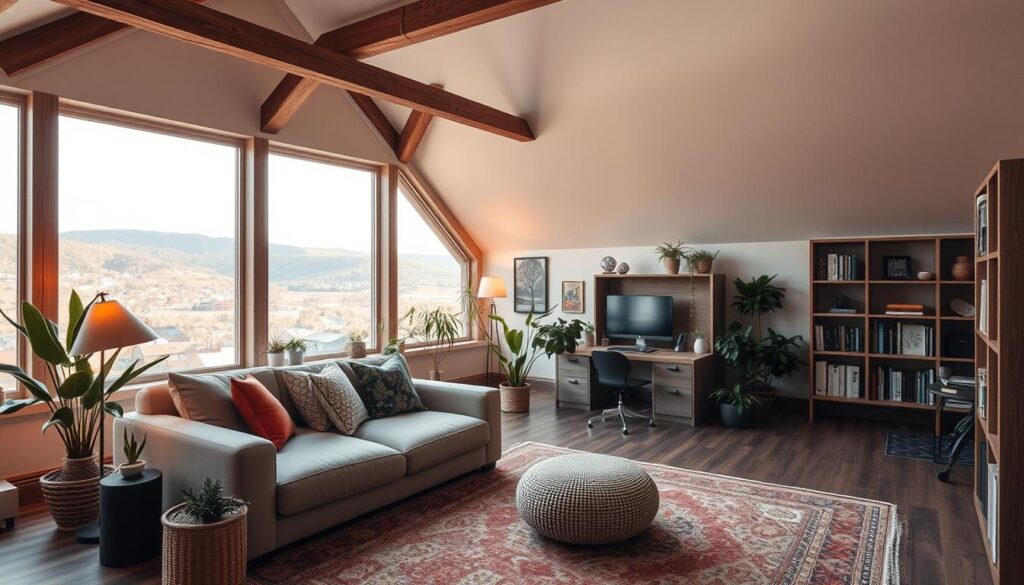Attic conversions let homeowners turn unused areas into useful and stylish rooms. This can make your home more valuable by up to 20%. It also means you can have more space without moving.
These conversions can be for many things. You could get extra bedrooms, a home office, a playroom, or even a quiet spot just for you.
Key Takeaways
- Attic conversions can unlock the potential of unused loft space and add valuable living area to your home.
- The process can significantly boost your property’s value, with an estimated increase of up to 20%.
- Attic rooms can be transformed into a variety of functional spaces, such as bedrooms, home offices, or playrooms.
- Careful planning and consideration of factors like head height, roof structure, and natural light are crucial for a successful conversion.
- Collaborating with experienced local builders in Northampton can ensure a smooth and compliant attic conversion project.
Understanding the Potential of Your Unused Loft Space
Many older homes in the UK have unused attic spaces. These areas were once just for storage. But now, they can be turned into cozy bedrooms, home offices, peaceful retreats, or fun spaces for the family.
Evaluating Head Height Requirements
Checking if there’s enough headroom is the first step for a loft conversion. Older homes might have low ceilings. You’ll need to plan carefully to ensure there’s enough room to live comfortably.
A loft assessment can show if the attic can be converted as planned. Or, if you need to raise the roof or add dormer windows for more headroom.
Assessing Structural Support
It’s also important to check the attic’s structural support. The type of roof affects the conversion and any needed repairs. A professional can find out which parts of the attic can handle the changes.
Checking Natural Light Possibilities
Adding natural light is key for a welcoming loft space. Skylights or dormer windows can make the loft brighter and more appealing. Knowing the roof’s layout and the property’s direction helps find the best light sources.
By looking at these important factors, homeowners can see the full potential of their loft. This knowledge is the first step to a successful and exciting loft conversion project.
“A well-designed loft conversion can not only add valuable living space to a home but also increase its overall appeal and market value.”
Essential Planning and Building Regulations in the UK
Thinking about an attic conversion? You must understand UK planning permission and building rules. Many loft changes are okay under “permitted development”. But, rules can change based on where your house is, how big the change is, and its effect on neighbours.
Following building regulations is key for safety and to avoid legal trouble. These rules cover things like how strong the building is, fire safety, energy use, and making sure everyone can move around easily. Not following these rules can cause big problems, like huge fines, having to take down the changes, and trouble selling your house.
- Loft conversions need to meet certain rules for windows, doors, stairs, roof changes, air flow, and fire safety.
- For houses that share walls, like terraced or semi-detached homes, there’s “The Party Wall Act 1996” in England and Wales.
- The “four-year rule” lets you get approval for loft changes done before, but you need a “Certificate of Lawfulness” for older properties.
Building rules change often, so it’s important to know the latest ones before starting your loft project. Different types of conversions, like Velux, hip-to-gable, dormer, and mansard, have their own rules about how strong the building is, insulation, and stairs.
| Regulation | Requirement |
|---|---|
| Head Height | Minimum of 2.4m for comfortable space post-ceilings and floor coverings |
| Staircase Installation | Minimum headroom of 1.9m at the center of the flight and 1.8m at the edges |
| Roof Structure | Cut roof (pre-1960) or trussed roof (post-1960s) |
| Loft Conversion Types | Flat roof dormer, gabled dormer, mansard, roof light, and hip-to-gable |
Knowing the UK’s planning and building rules helps homeowners confidently go through the conversion process. This way, they can make sure their attic change is legal and safe.
Popular Types of Attic Conversions
There are many ways to turn your attic into a useful space. Each method has its own benefits and fits different homes. Let’s look at some common attic conversion types:
Velux Conversions
Velux conversions use roof windows called Velux windows. They don’t change the roof’s shape. This is great for homes with enough room above and steep roofs. It’s also good for homes in areas where you can’t change the structure much.
Dormer Conversions
Dormer conversions add a vertical section to the roof. This gives more room and headspace in the loft. It’s perfect for old homes or city houses, keeping the attic’s charm.
Hip-to-Gable Conversions
Hip-to-gable conversions change the roof’s side to a vertical wall. It’s ideal for semi-detached or end-of-terrace homes. It makes the loft more open and easy to use.
Mansard Conversions
Mansard conversions change the roof to a flat top with a sloping back. It’s good for homes with little headroom, like semi-detached or terraced houses. It’s a cost-effective way to add more space.
| Conversion Type | Suitable Property Types | Estimated Cost per Sq. Meter | Typical Project Duration |
|---|---|---|---|
| Velux Conversion | Homes with sufficient headroom and steep roofs, conservation areas, listed buildings | £1,200 – £1,800 | 4 weeks |
| Dormer Conversion | Period properties, urban homes | £1,250 – £1,450 | 8 – 12 weeks |
| Hip-to-Gable Conversion | Semi-detached, end-of-terrace homes with limited headroom | £1,250 – £1,450 | 8 – 12 weeks |
| Mansard Conversion | Semi-detached, terraced houses with limited headroom | £1,500 – £2,500 | 6 – 8 weeks |
Choosing the right attic conversion depends on your home’s features. Always talk to professional builders to find the best and most affordable option for your attic makeover.
Maximising Space and Design Options
Loft conversions are all about making the most of the space and creating a welcoming area. With careful planning, your attic can become a valuable part of your home. It will blend smoothly with the rest of your living space.
Optimising space is key in loft conversion design. This means planning the layout well, adding storage, and choosing features that make the room feel bigger. Skylights, dormer windows, and recessed lighting bring in natural light, making the space feel more open.
Using built-in wardrobes or storage in the eaves can free up floor space. Light colours on walls and furniture also help make the room feel larger. Even the staircase’s placement can greatly affect how the space is used and felt.

Design choices in loft conversions go beyond layout and storage. You can pick from different roof styles like Velux, dormer, or hip-to-gable. Each has its own benefits in terms of space, light, and looks. A professional loft builder can help pick the right design for you, ensuring it meets your needs and building codes.
By carefully planning your loft conversion, you can create a unique living space. It will not only add value to your home but also provide a comfortable and versatile area for you to enjoy.
Cost Considerations and Property Value Benefits
Starting an attic conversion is a big step, but it’s often a wise choice. The cost can range from £20,000 to £30,000 for a basic 20m2 loft. More elaborate projects might cost over £50,000. Yet, the potential gain in property value makes it attractive to many.
Initial Investment Requirements
The cost of an attic conversion varies based on size, complexity, and design. Velux conversions cost between £15,000 and £25,000. Dormer conversions are £20,000 to £40,000. Hip-to-gable and mansard conversions can be more, up to £70,000.
Bungalow and modular loft conversions also vary, starting at £20,000.
Return on Investment Potential
The ROI of an attic conversion is impressive. A well-done loft conversion can increase a property’s value by 20% to 25%. In London, a two-bedroom house can see its value rise by 24.5% with a loft conversion.
Additional Value Benefits
An attic conversion does more than just increase property value. It adds living space, like a bedroom or office, making the home more functional and appealing. It also improves energy efficiency, saving on heating costs and boosting long-term value.
“A loft conversion is generally cheaper than an extension, making it a budget-friendly option for homeowners looking to maximise their property’s potential.”
When thinking about an attic conversion, consider the upfront cost against long-term gains. These include increased property value and a better living experience. With proper planning and expert advice, homeowners can fully utilise their attic space.
Creating a Versatile Living Environment
Attic conversions turn unused spaces into multi-functional areas. They meet changing lifestyle needs. You can design a space for a bedroom, home office, or playroom.
One big plus of attic conversions is saving on costs. They use the existing structure, cutting down on construction needs. This approach also means less disruption to your life.
Adding energy-efficient features is smart. Think about better insulation, energy-saving windows, and eco-friendly materials. These choices make your space more comfortable and save on bills.
| Feature | Benefit |
|---|---|
| Ample natural light | Creates a bright and airy atmosphere, reducing the need for artificial lighting |
| Proper insulation and ventilation | Maintains a comfortable temperature throughout the year, minimising energy consumption |
| Versatile flooring and wall finishes | Allows for personalisation and adaptability to suit diverse design preferences |
Attic conversions offer a space that grows with you. Whether it’s a home office, bedroom, or playroom, the key is to have a clear vision. Embrace the idea of adaptable living areas.

“Attic conversions are a brilliant way to transform unused spaces into versatile, custom-tailored living environments that truly reflect your lifestyle and aspirations.”
Essential Construction Elements and Safety Features
Starting an attic conversion means you need to focus on key construction and safety aspects. This includes making the floor strong, adding electrical and plumbing systems, and ensuring fire safety. These steps are crucial for a safe and comfortable living area.
Floor Reinforcement Requirements
The attic floor might need to be strengthened to handle more weight and use. This could mean adding more joists or making the current ones stronger. A professional will check what’s needed for your home.
Electrical and Plumbing Considerations
Planning electrical and plumbing systems is vital for an attic conversion. You might need new outlets, lights, and plumbing for a bathroom or kitchen. It’s important to make sure these systems are safe and meet current standards.
Fire Safety Measures
Fire safety is a top priority in attic conversions. This includes fitting smoke alarms, making sure there’s a safe way out, and checking windows and doors for emergency exits. Following local building and fire safety rules is essential for everyone’s safety.
| Construction Element | Importance | Key Considerations |
|---|---|---|
| Structural Reinforcement | Crucial for supporting increased weight and regular use | Installing additional joists or strengthening existing ones |
| Electrical Installation | Vital for providing power and lighting | Adding new outlets, lighting fixtures, and ensuring compliance with safety standards |
| Plumbing Considerations | Essential for integrating any bathroom or kitchenette facilities | Planning and installing necessary plumbing runs |
| Fire Safety Measures | Paramount for protecting occupants | Installing smoke alarms, ensuring adequate means of escape, and verifying emergency egress |
By focusing on these key construction and safety elements, you can turn your attic into a safe and useful living space. It will meet all legal standards and offer a comfortable home solution for years to come.
Interior Design and Storage Solutions
Turning your attic into a stylish and useful space is all about design and storage. It’s important to think carefully about how to make the most of your loft conversion. This means combining good looks with practicality.
Using built-in storage is a key part of attic design. By fitting wardrobes, shelves, and cabinets into the loft’s angles and corners, you can store lots without losing style. Skilled carpenters and joiners help make these custom storage solutions, ensuring they fit perfectly and use space well.
- Incorporating built-in wardrobes and cupboards that follow the contours of the sloped ceiling
- Designing drawers and shelves that maximise the potential of the eaves for organised storage
- Crafting freestanding chests of drawers and bookcases that fit snugly under the angled roof
Choosing furniture that does more than one thing is also key. Ottomans, daybeds, and Murphy beds offer both seats and beds. Shelves and hanging storage keep things tidy and looking good.
Colour and light are important too. Light colours and skylights make the attic feel bigger and warmer. The right lighting adds brightness and makes the space welcoming.
With the right interior design and storage solutions, your attic can become a beautiful and useful part of your home. It’s all about working with experts who know how to make the most of your attic. They’ll help you create a space-saving area that looks great and works well.
Professional Installation and Project Management
Transforming your unused loft space needs the right team. Look for loft conversion specialists with a good track record. They should communicate well and have happy customers. The right team can finish your conversion in 6-12 weeks, depending on the work.
Project management is key for a successful loft conversion. A good project manager will oversee everything. They’ll manage materials, schedules, and building rules. This saves you time, money, and stress, letting you enjoy planning your new space.
At Simply Loft, we offer a complete loft conversion service. Our certified team includes NICEIC electricians and Part P plumbers. We handle everything from start to finish, including party wall agreements and building approvals.
Choosing Simply Loft means you’ve picked a trusted builder. We’ve done many successful loft conversions in Sussex. Let us help you make your dream of extra living space come true.
“The team at Simply Loft delivered an exceptional loft conversion that exceeded our expectations. Their professional project management and attention to detail ensured a stress-free process from start to finish.”
Conclusion
Attic conversions are a great way for homeowners in the UK to add more space and value to their homes. They can turn unused attic space into a useful and stylish area. This is done by choosing the right design, following the rules, and hiring skilled workers.
There are many ways to convert an attic, like Velux, dormer, hip-to-gable, or mansard. These changes can make a home worth up to 20% more. They also provide extra room for families or home offices, fitting today’s lifestyle needs.
Investing in an attic makeover can boost your home’s value and look. It’s a smart move for home improvement and property enhancement. With good planning, following the rules, and the help of experts, the process is smooth. You’ll get a bright, useful, and valuable space.
FAQ
What are the key factors to consider when assessing the potential of an attic space?
When looking at an attic space, check if there’s enough room to stand up comfortably. Also, make sure the attic can support the weight of new features. Finally, think about how to bring in natural light with skylights or dormer windows.
Do I need planning permission for an attic conversion?
In the UK, many attic conversions don’t need planning permission. But, it’s important to check with your local planning office. Things like where your house is, how big the conversion will be, and how it might affect your neighbours can all play a part.
What are the different types of attic conversions to consider?
There are a few main types of attic conversions. Velux conversions add roof windows without changing the roof. Dormer conversions extend the roof vertically. Hip-to-gable conversions extend the ridge line of a hipped roof. And mansard conversions change the roof to create a flat top with a sloping back wall.
How can I maximise the space and design of an attic conversion?
To make the most of an attic conversion, plan the layout carefully. Decide what the room will be used for and how to store things. Light colours and features like built-in wardrobes can make the space feel bigger. Skylights or dormer windows bring in lots of natural light.
What are the typical costs and potential benefits of an attic conversion?
The cost of an attic conversion depends on its size, complexity, and materials. It’s a good investment, potentially adding 20% to your property’s value. Think about the long-term benefits, like more living space and a higher property value, when considering the initial cost.
How can an attic conversion create a versatile living environment?
Attic conversions can be very flexible. You can design the space for different uses, like a bedroom that’s also a home office. This flexibility means you can adapt to changing needs without big renovations.
What are the essential construction elements and safety features to consider?
Important construction elements include strengthening the floor and planning for electrical and plumbing. Make sure there’s a safe way to get up and down, like a proper staircase. Safety is key, with smoke alarms and windows big enough for escape.
How can I ensure a successful attic conversion project?
For a successful attic conversion, choose experienced professionals. Look for builders with a good track record in loft conversions. They should communicate well and have happy customers. Professional management means your conversion will be done well and quickly, usually in 6-12 weeks.

